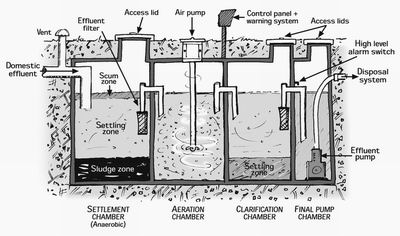Aerated Wastewater Treatment Systems
The term ‘Aerated Wastewater Treatment Systems (AWTS)’ covers a range of types of onsite treatment systems that provide additional treatment to septic tankffluent. Their mechanical pumps require regular maintenance and a continuous power supply.
In general, an AWTS has three parts which may be housed in a single unit or split into more than one unit (see diagram below).
 This is a generalised diagram of an AWTS. Designs may differ with different brands.
This is a generalised diagram of an AWTS. Designs may differ with different brands.
View a larger version of the Aerated Wastewater Treatment System diagram (JPG 73 KB)
The three main processes that take place in an AWTS are:
Settlement and anaerobic treatment
This takes place in a chamber or tank, and the process is identical to what happens in a septic tank. Solids within the effluent settle and are broken down by anaerobic bacteria (bacteria that can live without oxygen).
Aerated treatment
The effluent then enters a second chamber where aerobic bacteria (bacteria that require oxygen to live) break down the solids further and reduce the number of harmful bugs within the effluent. This normally happens by either passing the effluent over, or through, a material that contains aerobic bacteria or by pumping air directly into the effluent. In some AWTS, a combination of both methods may be used.
Final settlement (clarification)
After the aeration treatment, the effluent is allowed to settle before being pumped to a disposal system.
An AWTS removes a greater amount of solids from the effluent than a septic tank does and therefore problems within the disposal system caused by clogging are less likely. The additional treatment within the aerobic chamber should result in effluent that has fewer harmful bugs and nutrients, so it is less likely to be harmful to the environment.
The installation of an AWTS is particularly useful in areas where there is a high groundwater table that needs protection or where there are poorly draining soils.
If you are unsure whether your on-site effluent treatment system is an AWTS, please call the Northland Regional Council for advice on 0800 002 004.
Effluent disposal
Effluent from an AWTS is commonly disposed of through dripper irrigation lines, which are flexible pipes with small pressure-compensating drippers installed along their length. The drippers should be self flushing, which helps prevent them becoming clogged, and there should also be “flushing valves” at the end of each line for maintenance purposes.
The irrigation line is placed either under the soil surface or on the surface and covered with mulch, post peelings or a similar material. The irrigation lines can be laid around ornamental gardens to water plants, and are a useful means of recycling the effluent. Care is needed when handling the irrigation lines or working within any planted areas as there is still a significant health risk associated with this treated effluent.
It is also common for irrigation line disposal systems on sloping land where soils have poor soakage to be specially planted. These plants take up some of the effluent and use the nutrients to grow while the liquid evaporates through their leaves, and they can also prevent some of the rain from falling onto the disposal area. The disposal area needs to be properly planted to prevent effluent from running off during wet periods and causing a problem.
A short list of recommended plants can be found on page 14 of this booklet. Additional information can also be found on our website www.nrc.govt.nz/septictanks or by phoning 0800 002 004 to request a full list.
